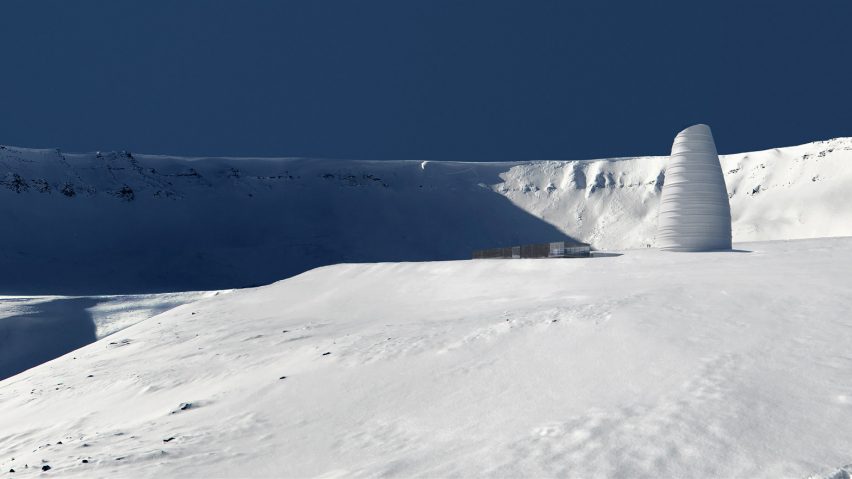Snøhetta has designed a visitor centre for two archives, which will be built within the Arctic Circle on the Norwegian island of Spitsbergen in the Svalbard archipelago.
Named The Arc, the building will be a place for people to digitally view items from the Svalbard Global Seed Vault, which is the world's largest, secure seed-storage, and the Arctic World Archive – a digital vault of the world's history and culture.
"Today, there is really no option for people to visit the seed vault," said Julie Aars, senior architect at Snøhetta.
"Several tourists try to visit it but get disappointed when they realise that they can only see it from the outside, as most of the vault is located underground with strict security measures," she told Dezeen.
"The visitor centre will let people experience what is stored inside the vault without going into the vault itself."
The visitor centre will be split into two clearly defined volumes.
The entrance building, which will contain the ticket office, a cafe and offices for staff, will be a rectangular structure made from cross-laminated timber (CLT) that will be raised above the ground on stilts. This building will be clad with burnt wood and dark glass panels and topped with solar panels.
Alongside the entrance block, and connected to it by an enclosed, glass-sided bridge, the exhibition building will be a large conical form.
"While the entrance building is rational and stoic, and something you might recognise from other buildings, the exhibition building is extravagant from the outside, yet introverted and mysterious on the inside," explained Aars.
"The exhibition building is formed to resemble something outside of time and space. The form can be interpreted as being timeless and scale-less – and is both familiar and otherworldly at the same time."
Inside the cone, Snøhetta has designed an exhibition space that resembles the form of the actual archive spaces, which are located underground within the permafrost – permanently frozen ground.
"The contrasting volumes are designed to give visitors the experience of going from a familiar entrance into a real vault inside the permafrost of Svalbard," said Aars.
"Upon entering the exhibition room, the audience will experience an enigmatic space that will allow them to contemplate and reflect while they take in the exhibition materials."
Visitors will be able to view some selective physical items from the archives alongside projections and VR experiences of digital items.
At the centre of the space is the ceremony room – an enclosed space for lectures and talks.
Snøhetta, and Arctic Memory AS that commissioned the building, hope that the visitor centre will help people learn about the world's physical and digital resources.
"The aim is to make available to the public archives and knowledge that is stored deep into the permafrost of Svalbard – to make it valuable not only to future generations but also to current ones," explained Aars.
"Moreover, we hope that the visitor centre will inspire people and have them contemplate the value of the world's resources and history, and how these need to be preserved, respected and managed for future generations to partake in the great progress of our civilisation as well."
Based in New York and Oslo, Snøhetta was founded in 1989 by Norwegian architect Kjetil Trædal Thorsen and American architect Craig Dykers. Last year the studio designed Europe's first underwater restaurant, which was shortlisted in the interior design category for the Dezeen Awards 2019.
Visualisations courtesy of Snøhetta and Plomp.

